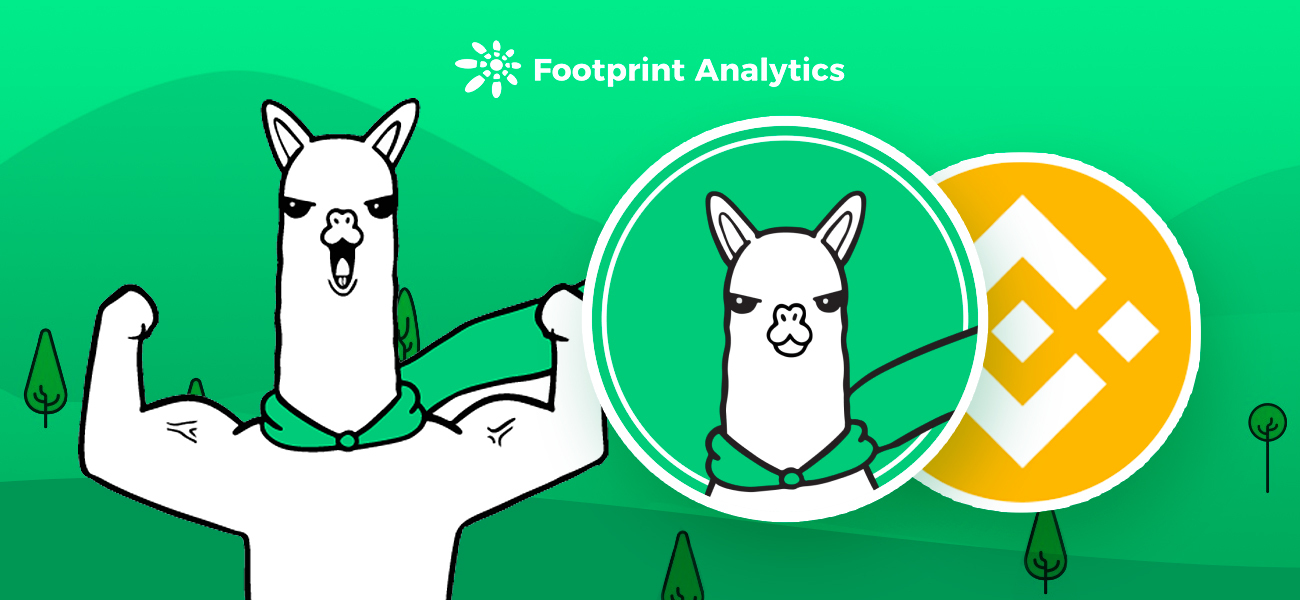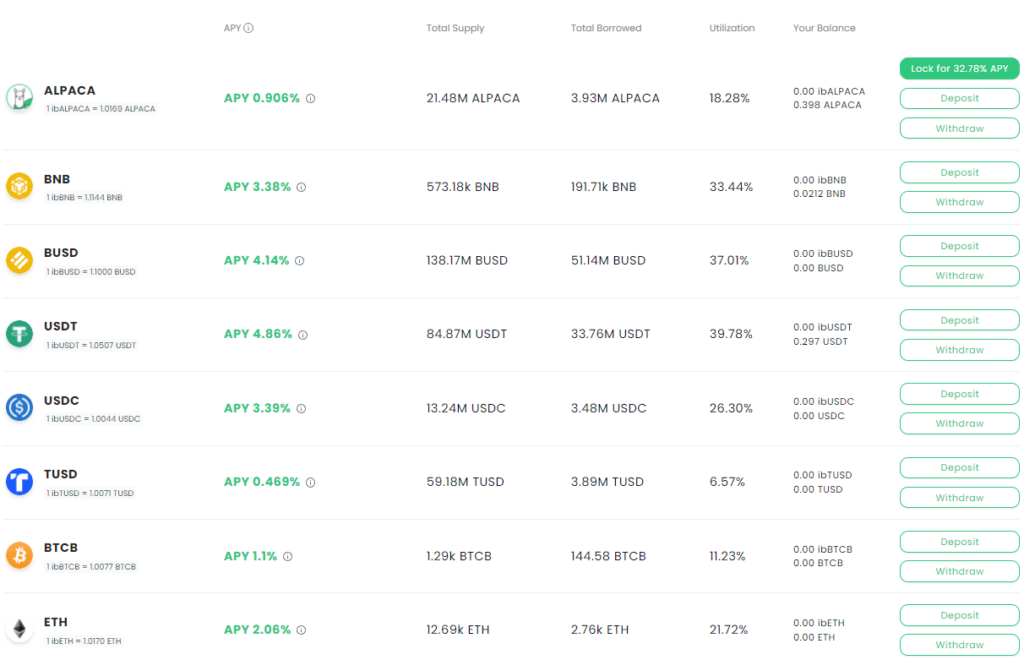

Alpaca Finance, is an all-in-one lending, liquidity mining, and stablecoin project that has become the third-largest BSC protocol by TVL.
The team created Alpaca after seeing the high gas fees on Ethereum and wanted to realize the full potential of BSC through liquidity mining. It has been more than 1 year since Feb. 2021 and still insists on being a fair launch project with no pre-sales, no investors and no pre-mine.
In this article, we’ll take a look at how Alpaca achieves all of this in conjunction with data from Footprint Analytics and Footprint DeFi 360.
On Alpaca, users can: 1. Yield farm, a great way to leverage income through limited capital, 2. Earn money by lending. Combining these main functions plus other features, users of different levels can choose the right investment for themselves.
For new investors, users can invest in a single asset in two simple steps via Lend and Stake.
The Lend interface offers deposits of 8 mainstream assets, including BNB, ETH, Stablecoin, BTCB, and ALPACA, which will result in an ibToken. ibToken can then be staked and rewarded with the platform token ALPACA or partner tokens in Graze.
Lenders earn from the interest paid by borrowers in the Farm, and the APY of each asset pool is tied to its utilization rate. Because Alpaca allows borrowers to use leveraged borrowing, the utilization and the interest rates are usually more than two times that of other lending protocols.
Borrowers will not withdraw their loans off the platform, while Alpaca will invest the loans in liquidity mining. The use and return will therefore be monitored by the protocol, giving lenders a safer guarantee.


Alpaca Finance – Available Lending Pools
Users who want to gain higher returns from liquidity mining but want to keep their risk low can choose to mine unleveraged in Farm, or choose leveraged mining in stablecoin-stablecoin farming pools.
Users can simply set the leverage multiple to 1x for unleveraged mining, which is currently supported across 59 pools in PancakeSwap and MDEX.
Users deposit only one token, and Alpaca will convert it to two assets 50:50 and deposit them to DEX. Alpaca will also automatically reinvest the rewards earned in the pool for the user.
For those who want to try leveraged mining for the first time, it is better to start with leveraged mining in stablecoin-stablecoin farming pools. Since the price of stablecoins is basically anchored to the US dollar, the price fluctuation is low making the risk of being liquidated more manageable.
For professional investors, there is the higher risk and higher reward option of leveraged farming of non-stablecoins. In addition to liquidity mining rewards and ALPACA token rewards, additional long/short gains are possible by going long/short on non-stablecoins.
Users can deposit an asset and set a leverage of over 2x, select any of the 8 assets in the Lend pool to borrow, and Alpaca will automatically convert the asset into a 50:50 liquidity pool for the user.
Users should always remember that the assets deposited are longed and the assets borrowed are shorted. The initial net exposure to risk is the net of both.
Due to the amplification of leverage, the interest on borrowings will also multiply, and leverage above 2x will cost additional gas fees to convert assets to equity. Note that the increased capital may also create greater slippage. While leverage may have high returns, it also has higher initial costs.
If a long/short position fails it may result in more losses, but more advanced users may choose to open two positions at the same time, one long and one short, to hedge the risk of both positions.
This double-sided leveraged yield farming turns the initial exposure neutral, but as the token price moves the exposure will change, with the exposure becoming short as the price rises and vice versa. Therefore it is also necessary for the user to weigh the potential losses, which can also be reset by adding collateral or reopening the position after closing.
Alpaca Finance – Hedging with Double-Sided Borrowing
The tokens associated with Alpaca are ALPACA and AUSD, the former being the platform’s governance token and the latter being the platform’s minted stablecoin.
Total distribution of ALPACA is 188 million, which will be released gradually over two years. Only 8.7% of ALPACA will be allocated to fund development and expand the team, 4.3% for future strategic expenses, and the remaining 87% will be distributed equitably to the users of the protocol.
ALPACA will be deflationary in the long run because of the burning mechanism. The platform will provide part of the protocol fee to buy back the token and burn it, such as 80% of the liquidation fee, 10% of the loan interest, and 4% of the liquidation bounty received by the liquidation robot. This helps the value of ALPACA to continue to rise in the future.
ALPACA is currently 11 months away from the end of its two-year unlocking period, with about 150 million in circulation. Although the burning mechanism has been ongoing, it is still some distance away from deflation and the current token price is about $0.4.
Footprint Analytics – ALPACA Token Price & Volume
Users receive governance voting rights in a similar way to Curve, by locking in ALPACA for varying lengths of time from 1 week to 1 year to receive a varying number of xALPACA tokens. Users who stake ALPACA also receive 5% of the revenue from the reward portion of the yield farming.
After depositing assets in Lend, users can choose to earn additional returns in Stake, or obtain a stablecoin AUSD by overcollateralizing ibToken, somewhat similar to Abracadabra. Users can then use AUSD to invest or convert to other tokens, increasing the efficiency of their capital.
AUSD stays anchored to the USD through arbitrageurs. From Footprint Analytics data, AUSD has not been significantly unanchored, but the price has been slightly below $1 most of the time.
Footprint Analytics – AUSD Token Price
In terms of trading volume, AUSD is still a long way from other stablecoins in terms of activity. As a latecomer, Alpaca need to provide richer and more valuable utility.
Footprint Analytics – AUSD Token Volume
Alpaca features leveraged yield farming but it is also possible to see both lenders and leveraged farming borrowers from the Lend pool. Data from Footprint DeFi 360 shows that the highest total supply of Lend pools on the BSC is BNB, followed by stablecoins such as BUSD.
Footprint Analytics – Alpaca Total Supply of Lend Pool
The choice of which assets a borrower puts into the pool is influenced by the pool’s APY, and the APY is influenced by the number of assets borrowed in the Farm. When an asset has a high utilization rate, that asset will receive more borrowed interest for distribution. The ranking of assets favored by borrowers is also similar to the ranking of assets deposited by lenders.
Footprint Analytics – Alpaca Total Borrow of Lend Pool
Total Borrowed have remained smooth over the last 90 days and total supply has been relatively stable except for BNB. This has led to a high variability in the utilization rate of BNB.
Footprint Analytics – Alpaca Lend Pool Utilization
The Lend and Farm pools interact with each other. The utilization rates of the top 2 pools, BNB and BUSD, are both decreasing over the 90-day period.
BNB’s borrowing APY used to be above 10% and utilization above 60%, but now it is only 3.56% APY and 34% utilization. This has led to a decline in Alpaca’s TVL as well.
Alpaca needs to attract more lenders by increasing the Lend APY to get a higher TVL, and a higher APY comes from a higher utilization rate. However, higher utilization rates increase the interest rate on borrowing, and borrowers need higher returns to cover the increased costs.
Leveraged farmers earn revenue primarily from liquidity mining rewards + fee income + ALPACA rewards ± gains/losses from changes in exposure prices.
With declining ALPACA issuance, there may be no more ALPACA rewards by Feb. 2023. Both liquidity mining rewards and fee revenue are largely influenced by the DEX platform. Alpaca needs to innovate more business models if it wants to keep giving users a high enough APY.
While the front few revenues are hardly increasing significantly, Alpaca further tries to optimize the shorting/longing exposure in leveraged farming with the Automated Vaults which will be launched.
Advanced users can hedge their risk by creating both long and short positions, but as the token price moves, the initial neutral exposure is shifted.
Compared to manually adjusting skewed exposures, Automated Vaults helps users auto-rebalance assets back to neutral exposure, with up to 8x leverage, no liquidation risk, auto-compounding and no lock-up.
Alpaca is the #3 protocol on BSC because of its great team. It covers a wide range of strategies from beginner to advanced in a fast and responsive way, and it does require more expertise to invest at an advanced level.
In addition, the team has taken security seriously. Alpaca has done 20 security audits, protected Chainlink from attacks with The Alpaca Guard, launched a Bug Bounty Program that gives high rewards for finding bugs, and for those who want to purchase insurance, has integrated Nexus Mutual Coverage and InsurAce are available.
Alpaca also launched Alpies NFT to pave the way for the second quarter release of play-to-earn games, and Alpaca will enter the GameFi field in the future. Alpaca’s innovations are always worth waiting for.
This piece is contributed by Footprint Analytics community.
The Footprint Community is a place where data and crypto enthusiasts worldwide help each other understand and gain insights about Web3, the metaverse, DeFi, GameFi, or any other area of the fledgling world of blockchain. Here you’ll find active, diverse voices supporting each other and driving the community forward.
Denver, Colorado, 24th February 2025, Chainwire
Denver, Colorado, 20th February 2025, Chainwire
Washington, D.C., 18th February 2025, Chainwire
Dubai, UAE, 27th January 2025, Chainwire
Those who enter the market at this time may be surprised to hear that Bitcoin…
George Town, Grand Cayman, 22nd November 2024, Chainwire